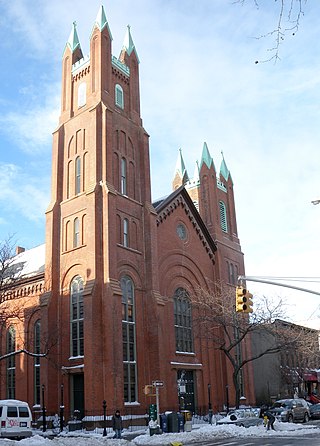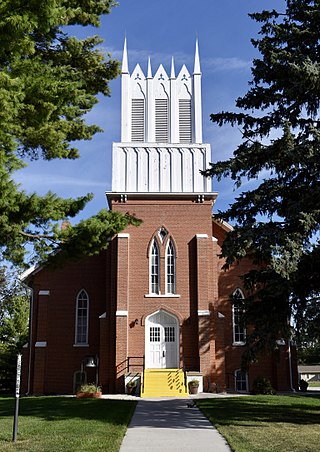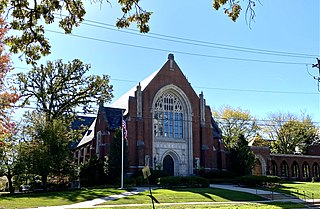
Olivet College is a private Christian liberal arts college located in Olivet, Michigan. The college is accredited by the Higher Learning Commission. It was founded in 1844 by missionaries from Oberlin College, and it followed Oberlin in becoming the second coeducational college or university in the United States. Olivet College is affiliated with the United Church of Christ and the National Association of Congregational Christian Churches and stands in the Reformed tradition of Protestantism.

Antoinette Louisa Brown, later Antoinette Brown Blackwell, was the first woman to be ordained as a mainstream Protestant minister in the United States. She was a well-versed public speaker on the paramount issues of her time and distinguished herself from her contemporaries with her use of religious faith in her efforts to expand women's rights.
John Todd was an American Congregationalist minister, co-founder of Tabor College in Tabor, Iowa, a leading abolitionist and a conductor reon the Underground Railroad.

The First Church of Christ, Congregational is a historic church at 75 Main Street in Farmington, Connecticut. Built in 1771, this Greek Revival church was designated a National Historic Landmark in 1975 for its role in sheltering the Amistad Africans before their return to Africa.

The John Brown Museum, also known as the John Brown Museum State Historic Site and John Brown Cabin, is located in Osawatomie, Kansas. The site is operated by the Kansas Historical Society, and includes the log cabin of Reverend Samuel Adair and his wife, Florella, who was the half-sister of the abolitionist John Brown. Brown lived in the cabin during the twenty months he spent in Kansas and conducted many of his abolitionist activities from there. The museum's displays tell the story of John Brown, the Adairs and local abolitionists, and include the original cabin, Adair family furnishings and belongings, and Civil War artifacts.
First Church, Old First Church, or First Church Parsonage may refer to:

Sayville Congregational Church, also known as Sayville Congregational United Church of Christ, is a historic Congregational church at 131 Middle Road in Sayville, Suffolk County, New York. It was built in 1888 and is a Shingle Style building with a cross gabled roof, two prominent towers, and fish-scale shingles. It features a three-story, square bell tower with rounded, turret-like corners.
First Congregational Church and Society of Volney, also known as Bristol Hill Church, Congregational United Church of Christ, is a historic Congregational church located at Volney in Oswego County, New York. It is a frame vernacular Federal style structure built in 1832–1835. It is a two-story structure, rectangular in plan, 40 feet wide and 54 feet deep. A tower extends from the center of its facade. Except for the loss of its bell, the church is in virtually original condition. Early members of the church were abolitionists and the church is known to have had African American members dating to the 1820s.

The South Congregational Church is a former Congregational and United Church of Christ church building complex located on the intersection of Court and President Streets in Carroll Gardens, Brooklyn, New York City. The complex consisting of a church, original chapel, ladies parlor, and rectory was designated a city landmark by the New York City Landmarks Preservation Commission on March 23, 1982. It was added to the National Register of Historic Places on November 4, 1982.

Plymouth Congregational Church of Lawrence, Kansas is an affiliate of the United Church of Christ that was established in 1854, months after the Territory of Kansas was opened to settlement. The present-day church building, built in 1870, is listed on the National Register of Historic Places.
Denmark Congregational United Church of Christ is located in Denmark, Iowa, United States. The church building was listed on the National Register of Historic Places as Denmark Congregational Church in 1977. The church is noteworthy because of its association with the Rev. Asa Turner, Jr. He was a noted abolitionist and supporter of the temperance movement, who was the pastor of the congregation in its early years. He was an early Congregationalist missionary to Iowa and encouraged the American Home Missionary Society to send more missionaries to the Iowa Territory. His requests resulted in the arrival of nine young men from Andover Theological Seminary in 1843. Known as the "Iowa Band", they established churches in eastern Iowa based on Turner's Denmark church.

First Congregational United Church of Christ is a historic church at 700 Poyntz Avenue in Manhattan, Kansas. It is listed on the National Register of Historic Places as First Congregational Church.

Tabor Congregational Church is a historic Congregational church at 403 Elm Street in Tabor, Iowa, USA.

First Congregational Church of Austin, also known as Greater Holy Temple of God in Christ, is a historic church at 5701 West Midway Place in Chicago, Illinois. The church was built in 1905 for a Congregational assembly; it was later used by Seventh-Day Adventist, Roman Catholic, and Church of God in Christ congregations. A Chicago building permit was issued on August 15, 1905 according to the Chicago Tribune of August 16, 1905. Architect William Eugene Drummond, a student of Louis Sullivan and a sometime employee of Frank Lloyd Wright, designed the church in the Prairie School style; it is an unusual example of a Prairie School church and influenced Wright's Unity Temple which was designed after the original church burned on June 4, 1905. The one-story building consists of a tall central section with massive piers and a smaller section to either side. The entrance is recessed in the base of the central section; the doorway features lintels and posts that continue the building's rectilinear emphasis. Leaded glass windows are recessed in the spaces between the central section's piers.

Union Park Congregational Church and Carpenter Chapel is a historic church building at 60 N. Ashland Blvd. on the Near West Side of Chicago, Illinois. The chapel is named after Philo Carpenter, a deacon, a co-founder of the congregation and of the Chicago Theological Seminary, and an early donor of the original church who was also a noted abolitionist and the city's first druggist. The two buildings are considered as a unit; together, they are a Chicago Landmark and an Illinois Historic Landmark and are listed on the National Register of Historic Places. The church building is currently occupied by the First Baptist Congregational Church, whose official mailing address is 1613 W. Washington Blvd. in Chicago.

The Old Stone Congregational Church, also known as the First Congregational Church of Lyons, is a historic church in Lyons, Colorado, built in 1894-5 and listed on the National Register of Historic Places in 1976.

First Congregational Church is a United Church of Christ church located in downtown Atlanta at the corner of Courtland Street and John Wesley Dobbs Avenue. It is notable for being the favored church of the city's black elite including Alonzo Herndon and Andrew Young, for its famous minister Henry H. Proctor, and for President Taft having visited in 1898.
The American Home Missionary Society was a Protestant missionary society in the United States founded in 1826. It was founded as a merger of the United Domestic Missionary Society with state missionary societies from New England. The society was formed by members of the Presbyterian, Congregational, Associate Reformed, and Dutch Reformed churches with the objective "to assist congregations that are unable to support the gospel ministry, and to send the gospel to the destitute within the United States." In 1893, the Society became exclusively associated with the National Council of Congregational Churches and was renamed the Congregational Home Missionary Society.

The First Congregational United Church of Christ in Belle Fourche, South Dakota was listed on the National Register of Historic Places in 2013.

Plymouth Church is an historic congregation located in Des Moines, Iowa and is a member of the United Church of Christ. Plymouth is known for its long history of social justice work including anti-racism and suffrage advocacy, ClimateCare, and aid to unhoused and refugee populations. Plymouth Church is an Open and Affirming church, a Stephen Ministries church, and a Just Peace Church. The church building, located at 42nd and Ingersoll Avenue, is included as a contributing property in the Greenwood Park Plats Historic District and listed on the National Register of Historic Places in 2013. The official name of the church is Plymouth Congregational Church of the United Church of Christ.



















